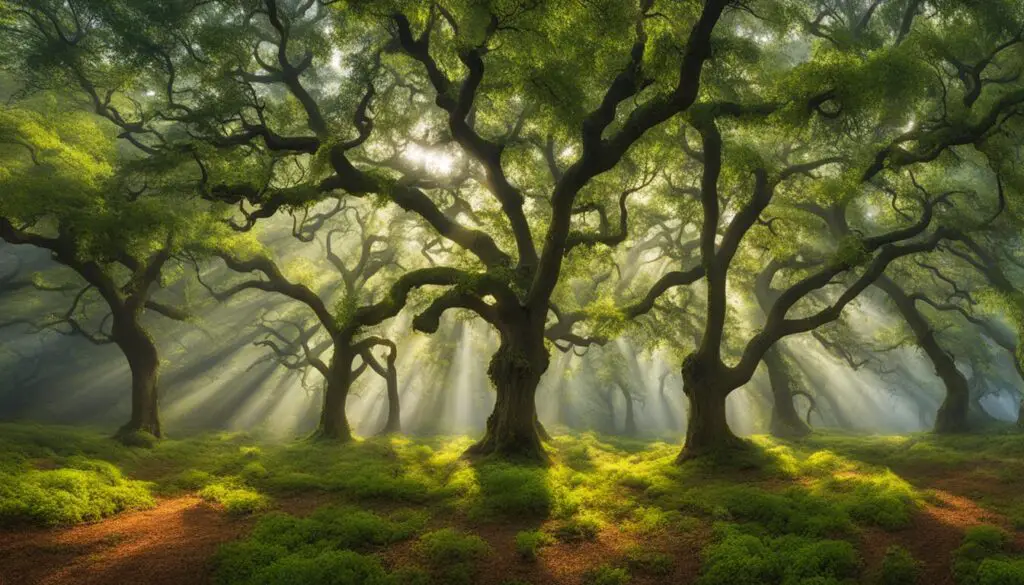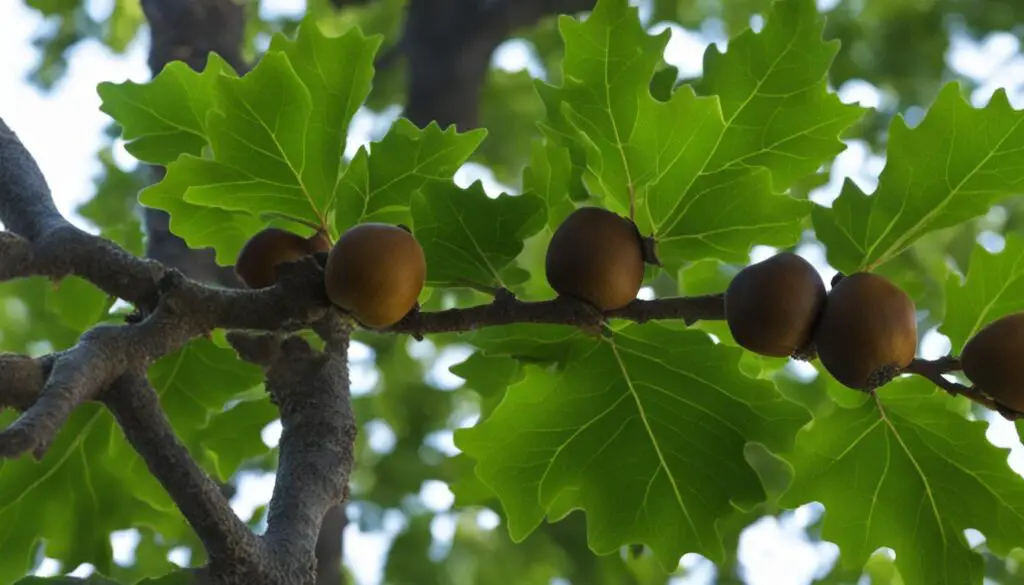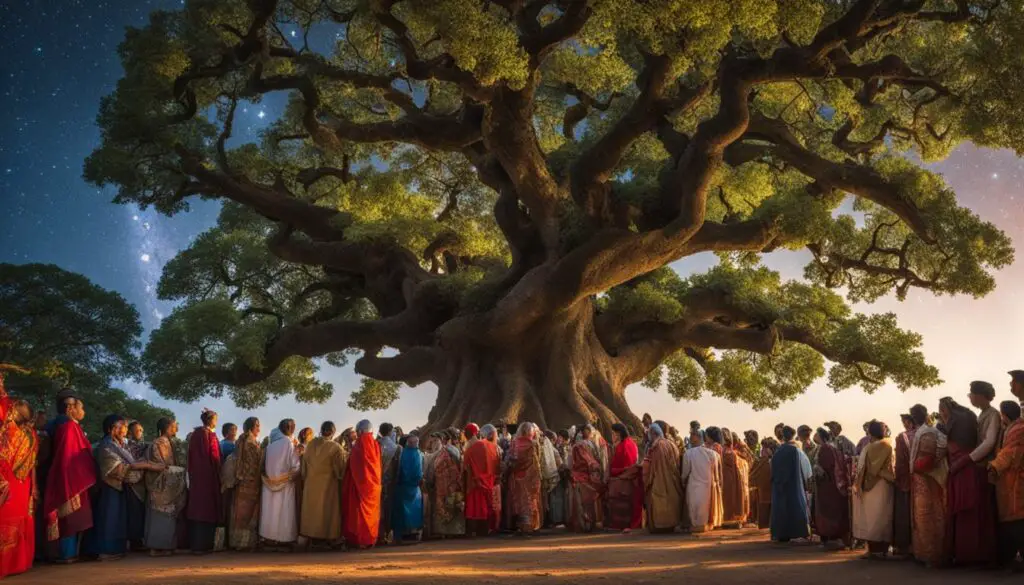Oak trees are truly remarkable for their longevity and biodiversity. These magnificent trees can live for centuries, with some species even reaching the impressive age of over 1,000 years. With approximately 500 different species spread across the globe, oak trees are considered the kings of biodiversity, providing habitats for over 2,300 associated species.
However, the oak tree population is facing significant challenges. Currently, 78 species of oak are classified as endangered, and this number continues to rise. Invasive pests, diseases, climate change, deforestation, and urbanization are all threats that jeopardize the existence of these majestic trees.
Key Takeaways:
- Oak trees can live for centuries, with some species exceeding 1,000 years of age.
- There are approximately 500 species of oak around the world.
- Oak trees support over 2,300 associated species, making them vital for biodiversity.
- 78 species of oak are currently classified as endangered.
- Invasive pests, diseases, climate change, deforestation, and urbanization pose significant threats to oak tree populations.
The Oldest Oak Trees in the World
The world’s oldest oak trees are remarkable examples of longevity and resilience. These ancient giants have withstood the test of time, standing as living monuments to the power and beauty of nature.
One of the most notable oldest oak trees is the Pechanga great oak, located in California. Estimated to be at least 2,000 years old, it is considered the oldest living oak tree in the world. This magnificent specimen is a source of awe and inspiration, reminding us of the rich history and deep roots of oak trees.
Another ancient oak tree of significance is found at Blenheim Palace in the UK. Believed to be 1,046 years old, this oak tree has witnessed centuries of human history and continues to thrive in its majestic presence.
These ancient oak trees are more than just impressive examples of age; they symbolize the enduring strength and resilience of oak trees. Despite the passage of time and the challenges they have faced, these majestic giants stand tall, serving as a testament to the power and beauty of nature.
| Oak Tree | Location | Age |
|---|---|---|
| Pechanga Great Oak | California, USA | Over 2,000 years |
| Blenheim Palace Oak | Oxfordshire, UK | 1,046 years |
The Importance of Oak Trees in Biodiversity
Oak trees are not only majestic, but they also play a vital role in supporting biodiversity. Their significance lies in the diverse array of species that are associated with oak trees, creating a thriving ecosystem.
Up to 2,300 species have been identified to be closely linked with oak trees. These include birds, bryophytes, fungi, invertebrates, lichens, and mammals. A fascinating aspect is that some species can exclusively be found on oak trees, highlighting their uniqueness and the critical role oak trees play in their survival.
One of the most noticeable contributions of oak trees to biodiversity is their role as habitats and food sources. Oak trees provide shelter, nesting places, and food for a wide range of wildlife, especially birds and pollinators. These species rely on the oak tree’s resources for survival and reproduce within the oak tree’s canopy, strengthening the interconnectedness of the ecosystem.

The diversity found within oak trees results in a healthier and more resilient ecosystem. The complex relationships between oak trees and associated species promote balance, stability, and sustainability within the natural world.
Oak Trees and Human History
Oak trees have played significant roles in human history and culture. Revered in mythology and folklore, they symbolize strength and endurance. The rich symbolism of oak trees can be traced back to ancient times, where they were associated with various deities and mythological stories. In Greek mythology, the oak tree was dedicated to Zeus, the king of the gods, representing power and protection.
In addition to their mythological significance, oak trees have had practical uses throughout history. In ancient times, oak bark was used to create a black dye for ink. This ink, known as “oak gall ink,” was widely used for writing and calligraphy. The production of oak ink involved fermenting oak galls – small, round growths on oak trees caused by wasp larvae – in an iron salt solution, resulting in a dark pigment suitable for writing.
The versatility of oak trees extended beyond ink production. Their acorns served as an important food source for early civilizations, providing sustenance in times of scarcity. Native American tribes, such as the Apache and the Pueblo people, incorporated acorns into their diet by grinding them into flour and using them to make bread, porridge, or soups.
Moreover, oak wood, particularly white oak, gained prominence in ship-building due to its durability and resistance to water-loss and decay. The strength and reliability of oak made it a preferred choice for constructing the frames and planks of ships. Its widespread use in ship-building contributed to the expansion of naval exploration during the Age of Discovery.

In addition to ship-building, oak wood plays a crucial role in the aging process of whiskey and wine. Oak barrels are used to store and age these alcoholic beverages, imparting distinct flavors and characteristics. The porous nature of oak allows for the interaction between the alcohol and the wood, resulting in the development of complex flavors over time. The process of aging in oak barrels enhances the taste, aroma, and quality of the final product.
The historical and cultural significance of oak trees is a testament to their enduring presence in human civilization. From mythology and ink production to ship-building and barrel aging, oak trees have left an indelible mark on our history and continue to be cherished for their symbolism, utility, and natural beauty.
Threats to Oak Trees and Conservation Efforts
Oak trees are facing numerous threats that are significantly impacting their populations. These threats are leading to the potential extinction of many oak species worldwide, which calls for urgent action in the form of conservation efforts.
The Red List of Oaks 2020 report provides valuable insights into the distribution, population trends, and threats faced by oak trees. According to this report, approximately 31% of the world’s oak species are currently threatened with extinction.
The main threats to oak trees include:
- Invasive pests
- Diseases
- Climate change
- Deforestation
- Urbanization
These factors contribute to the decline of oak tree populations by affecting their habitat, health, and ability to reproduce.
In order to combat the oak tree extinction crisis, conservation efforts are crucial. Various organizations and initiatives have been established to protect oak tree populations and promote their conservation.
One notable initiative is the creation of the Global Conservation Consortium for Oak. This consortium aims to prioritize and guide conservation efforts, focusing on regions that are particularly vulnerable to oak tree threats. Mexico, China, Vietnam, and the United States are among the countries that are prioritized for conservation efforts.
Through these conservation initiatives, it is hoped that the decline of oak trees can be reversed, ensuring their long-term survival and the preservation of their ecological contributions.
The Role of Oaks in Ecosystems
Oaks play a critical role in supporting diverse ecosystems by providing important services to a wide range of organisms. These magnificent trees support a variety of insects, birds, mammals, fungi, and other organisms, contributing to the overall health and balance of their surrounding environments.
Insects and Oak Trees: One of the key relationships between oak trees and ecosystems is their support for various insect species. Caterpillars, in particular, rely on oak trees as a crucial food source. This relationship is essential for the survival and reproduction of caterpillars, which in turn sustain bird populations by serving as a vital source of food for their nestlings.
Oak Tree Leaf Litter: The leaf litter produced by oak trees plays a vital role in supporting detritovores and fungi. As oak leaves decompose, they create a nutrient-rich layer on the forest floor, providing a habitat for organisms that break down organic matter, such as insects, bacteria, and fungi. This decomposition process contributes to the cycling of nutrients and the maintenance of a healthy ecosystem.
Marcescence and Oak Trees: Another fascinating phenomenon associated with oak trees is marcescence, which refers to the retention of dead leaves on the branches during winter. This characteristic is distinct to some oak species. While the exact reason for marcescence is not fully understood, scientists propose that it may serve as a defense mechanism against bud-eating animals, such as deer, and provide protection for new leaf buds that emerge in spring. Moreover, the accumulation of marcescent leaves beneath the tree can add nutrient-rich mulch to the soil, supporting the oak tree’s growth and overall health.
In summary, oak trees offer invaluable ecosystem services by supporting a wide range of organisms, from insects to birds, fungi to mammals. Their relationship with caterpillars provides a vital link in the food chain, impacting bird populations and contributing to overall ecosystem stability. Additionally, oak tree leaf litter and the phenomenon of marcescence contribute to the nutrient cycling and protection of the tree itself. Understanding and conserving these essential ecological roles of oak trees are crucial for preserving the health and balance of our ecosystems.
Oak Trees and Acorn Production
Oak trees are well-known for their abundant acorn production. A fully mature white oak tree can yield thousands of acorns each season. Acorns serve as an important food source and have been consumed by humans throughout history.
Superfood Status: Acorns pack a nutritional punch. They are rich in carbohydrates, fiber, protein, and beneficial fats. They also contain essential minerals such as calcium, potassium, and magnesium, making them a true superfood.
Native American tribes have long recognized the nutritional value of acorns and incorporated them into their diets. Traditionally, acorns were ground into flour and used in various meals, from bread and porridge to soups and stews.
Historical Significance: Acorns played a crucial role in the survival of ancient civilizations. These nutrient-dense nuts sustained human populations for thousands of years and were a staple food source in many regions.
Today, acorn consumption continues in some cultures, highlighting the lasting impact of the oak tree on human history. Incorporating acorns into modern cuisine not only preserves traditions but also offers a sustainable and nutritious food option.
To learn more about the historical use of acorns, check out the following table:
| Region | Acorn Usage |
|---|---|
| North America | Ground into flour for cooking |
| Europe | Used in bread, soups, and stews |
| Asia | Incorporated into traditional desserts |
| Africa | Roasted and eaten as a snack |

Oak Trees in Folklore and Traditions
Oak trees have a rich history associated with folklore and traditions, spanning various ancient cultures and civilizations. One such culture that held oak trees in high esteem were the Druids, an ancient Celtic order. They believed that oak trees served as conduits for spiritual energy and inspiration, considering them sacred and powerful.
The significance of oak trees being frequently struck by lightning was also observed by the ancient Druidic ancestors. They believed that lightning strikes on oak trees symbolized divine communication and brought about moments of artistic inspiration. This association between oak trees, lightning, and inspiration held great importance in their belief system.
Moreover, oak trees have maintained their symbolic importance in other cultures and traditions throughout history. They have been seen as symbols of strength, endurance, and wisdom. Many ancient civilizations incorporated oak tree symbolism into their myths, legends, and religious practices.
The revered status of oak trees in ancient cultures is a testament to their profound impact on human societies. Their symbolism and significance continue to resonate today, connecting us to the rich tapestry of our collective history.

Some Examples of Oak Tree Symbolism in Ancient Cultures:
- In Greek mythology, the oak tree was associated with Zeus, the king of the gods. It was believed to be a symbol of Zeus’ strength and power, as well as a sacred tree.
- In Norse mythology, the oak tree was associated with Thor, the god of thunder. It was believed that Thor would protect those who sought refuge beneath an oak tree during a thunderstorm.
- In Celtic mythology, the oak tree was seen as a symbol of the sacred king and the gateway to the Otherworld. It was believed that oak trees were inhabited by spirits and served as portals to the realm of the supernatural.
- In Roman mythology, the oak tree was associated with Jupiter, the king of the gods. It was believed to be a symbol of strength, endurance, and protection.
These examples highlight the widespread recognition of oak trees as powerful symbols in ancient cultures and the enduring significance they hold in our collective consciousness.
Conclusion
The preservation of oak trees is of paramount importance due to their remarkable longevity, biodiversity, and indispensable role in supporting ecosystems and wildlife. Unfortunately, oak tree populations worldwide are under threat, with many species at risk of extinction.
To safeguard oak trees and their ecological significance, urgent conservation efforts are required. By raising awareness about the importance of oak tree conservation, we can encourage individuals, communities, and organizations to take action. This may involve implementing sustainable land management practices, supporting reforestation initiatives, and combatting the invasive pests and diseases that pose significant threats to oak tree populations.
By recognizing the value of oak trees as vital components of our planet’s ecosystems, we strengthen our commitment to their protection and preservation. Conserving oak trees ensures the continuity of habitat for countless associated species, from birds and mammals to fungi and invertebrates. Furthermore, oak trees provide essential ecosystem services, such as supporting pollinators, maintaining soil health through leaf litter, and contributing to the overall biodiversity of our planet.
In conclusion, oak tree conservation is not only crucial for the survival and well-being of these majestic trees but also for the overall health and balance of our natural world. By valuing and safeguarding oak trees, we secure a sustainable future for generations to come, where the beauty, resilience, and ecological importance of these magnificent trees continue to thrive.
FAQ
How many oak trees are there in the world?
The exact number of oak trees in the world is uncertain, as they are widely distributed across various continents. However, there are approximately 500 species of oak trees worldwide, collectively supporting over 2,300 associated species.
What are the oldest oak trees in the world?
The Pechanga great oak in California is considered the oldest living oak tree, estimated to be at least 2,000 years old. Another notable ancient oak tree is located at Blenheim Palace in the UK, which is believed to be 1,046 years old.
How do oak trees contribute to biodiversity?
Oak trees play a crucial role in supporting biodiversity. Up to 2,300 associated species, including birds, bryophytes, fungi, invertebrates, lichens, and mammals, are known to be associated with oak trees. Some species can only be found on oak trees, emphasizing their uniqueness and importance. Oak trees also provide habitat and food sources for a wide range of wildlife, including birds and pollinators.
What is the significance of oak trees in human history?
Oak trees have been revered in mythology and folklore, symbolizing strength and endurance. They have been used to make ink in ancient times, and their acorns served as an important food source for many civilizations. Oak wood, especially white oak, was highly valued for ship-building due to its resistance to water loss and decay. Oak trees continue to play important roles in aging whiskey and wine in oak barrels, imparting distinct flavors.
What are the threats to oak trees and what conservation efforts are being made?
Oak trees are facing threats from invasive pests, diseases, climate change, deforestation, and urbanization. Approximately 31% of the world’s oak species are currently threatened with extinction. Conservation efforts are necessary to protect oak tree populations, with a focus on countries like Mexico, China, Vietnam, and the United States. The Global Conservation Consortium for Oak has been established to prioritize and guide conservation efforts.
What ecosystem services do oak trees provide?
Oak trees support a wide range of insects, birds, mammals, fungi, and other organisms, contributing to important ecosystem services. Caterpillars rely on oak trees for food, which in turn supports the health of bird populations. Oak tree leaf litter also plays a vital role in supporting detritovores and fungi. The phenomenon of marcescence, where dead leaves persist on oak trees, may serve as a defense mechanism against bud-eating animals and provide nutrient-rich mulch for the tree.
How many acorns does an oak tree produce?
Oak trees produce a significant number of acorns. A fully mature white oak tree can yield thousands of acorns each season. Acorns are highly nutritious and have been used as a food source throughout human history. Native American tribes traditionally ground acorns into flour and incorporated them into various meals.
What is the significance of oak trees in folklore and traditions?
Oak trees have held symbolic importance in various cultures and traditions throughout history. They were highly revered by ancient cultures such as the Druids, who believed oak trees were conduits for spiritual energy and inspiration. The fact that oak trees are often struck by lightning was considered significant by ancient Druidic ancestors, who believed it brought about moments of artistic inspiration.
Why is oak tree conservation important?
Oak trees are not only remarkable in their longevity and biodiversity but also play a crucial role in supporting ecosystems and wildlife. However, their populations are facing threats and many species are at risk of extinction. Conservation efforts and awareness are essential to protect oak trees and preserve their ecological importance.

